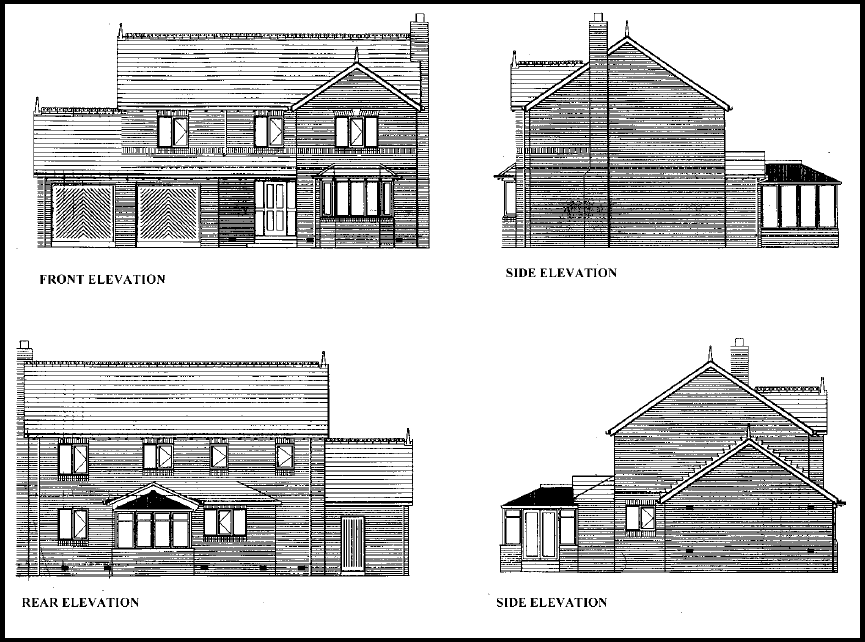Elevations
Contents |
[edit] What is orthographic projection?
Orthographic projection is a technique for drawing a three dimensional object in two dimensions, by ‘projecting’ its surfaces into a two dimensional representation, where the projection lines are orthogonal to (perpendicular to) the projection plane (that is, there is no foreshortening or perspective).
[edit] What are elevation drawings?
In the construction industry, the term ‘elevation’ refers to an orthographic projection of the exterior (or sometimes the interior) faces of a building, that is, a two-dimensional drawing of the building’s façades. An elevation drawing is a first angle projection that shows all parts of the building as seen from a particular direction with the perspective flattened. Generally, elevations are produced for four directional views, for example, north, south, east, west.
[edit] What should elevation drawings include?
Simple elevation drawings might show:
- The outline of a building.
- The exterior walls, and sometimes the finishes of the walls.
- Openings such as doors and windows.
- Roofing.
- Exterior features such as chimneys, decks, porches and steps.
- Any portion of the foundation that may be visible.
- Projections such as eves and rainwater pipes.
- Level datums such as finished ground level and floor positions.
- Key dimensions such as wall lengths and heights.
- A title block, including the name, number and revision of the drawing, the date of preparation, who the drawing was prepared by, project details, drawing scale, north point and so on.
However, they can contain a great deal more detail depending on the complexity of the buildings the reason for their preparation.
Insufficient information on elevations can mean that they do not properly satisfy the need for which they were prepared, however, very detailed elevations can be time-consuming and expensive to prepare and confusing to read. It is important therefore that the reason for the drawing is clear and the level of detail required satisfies that need.
[edit] What are elevations used for?
Elevations might be prepared for a number of reasons, including:
- As part of a survey of existing buildings.
- To create a record of an existing building.
- To explore and communicate interior and exterior design options.
- As part of an application for planning permission.
- As part of an application for building regulations approval.
- To communicate construction information.
- For sales and marketing.
[edit] How are elevations prepared?
Historically, buildings have been drawn by hand on two dimensional paper, and so orthogonal projection and the drawing of two dimensional plans and elevations have been the standard means of representation.
However, increasingly, buildings are being drawn using computer aided design (CAD) or building information modelling (BIM) software that represents them in three dimensions. Where these digital methods of drawing create 3d model of the building, two-dimensional elevations can be generated automatically from the 3D models, they do not need to be drawn individually.
[edit] Alternative meaning of elevation
The term 'elevation' might also be used to refer to the height of something above or below a fixed reference point or datum.
[edit] Related articles on Designing Buildings
- As-built drawings and record drawings
- Assembly drawing.
- Building information modelling.
- CAD layer.
- Computer aided design.
- Concept drawing.
- Detail drawing.
- Engineering drawing.
- Façade.
- Floor plan.
- General arrangement drawing.
- Notation and symbols.
- Orthogonal plan.
- Paper sizes.
- Principal elevation.
- Projections.
- Scale drawing.
- Standard hatching styles for drawings.
- Superelevation.
- Technical drawing.
- Techniques for drawing buildings.
- Types of drawings for building design.
- Working drawing.
[edit] External references
- The House Plans Guide – Elevation drawings
Featured articles and news
One of the most impressive Victorian architects. Book review.
RTPI leader to become new CIOB Chief Executive Officer
Dr Victoria Hills MRTPI, FICE to take over after Caroline Gumble’s departure.
Social and affordable housing, a long term plan for delivery
The “Delivering a Decade of Renewal for Social and Affordable Housing” strategy sets out future path.
A change to adoptive architecture
Effects of global weather warming on architectural detailing, material choice and human interaction.
The proposed publicly owned and backed subsidiary of Homes England, to facilitate new homes.
How big is the problem and what can we do to mitigate the effects?
Overheating guidance and tools for building designers
A number of cool guides to help with the heat.
The UK's Modern Industrial Strategy: A 10 year plan
Previous consultation criticism, current key elements and general support with some persisting reservations.
Building Safety Regulator reforms
New roles, new staff and a new fast track service pave the way for a single construction regulator.
Architectural Technologist CPDs and Communications
CIAT CPD… and how you can do it!
Cooling centres and cool spaces
Managing extreme heat in cities by directing the public to places for heat stress relief and water sources.
Winter gardens: A brief history and warm variations
Extending the season with glass in different forms and terms.
Restoring Great Yarmouth's Winter Gardens
Transforming one of the least sustainable constructions imaginable.
Construction Skills Mission Board launch sector drive
Newly formed government and industry collaboration set strategy for recruiting an additional 100,000 construction workers a year.
New Architects Code comes into effect in September 2025
ARB Architects Code of Conduct and Practice available with ongoing consultation regarding guidance.
Welsh Skills Body (Medr) launches ambitious plan
The new skills body brings together funding and regulation of tertiary education and research for the devolved nation.
Paul Gandy FCIOB announced as next CIOB President
Former Tilbury Douglas CEO takes helm.
























Comments
[edit] To make a comment about this article, or to suggest changes, click 'Add a comment' above. Separate your comments from any existing comments by inserting a horizontal line.